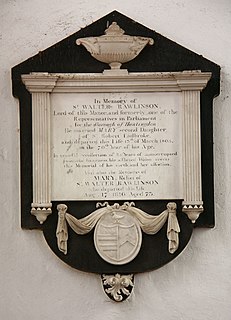Related Research Articles
Sir Thomas Bloodworth, born Blidward, also spelled Bludworth was an English merchant and politician who sat in the House of Commons from 1660 to 1679. He was Lord Mayor of London from October 1665 to October 1666 and his inaction during the early stages of the Great Fire of London was widely criticised as one of the causes for the great extent of the damage to the city.

Henry Jerome de Salis, DD, FRS, FSA, was an English churchman. He was Rector of St. Antholin in the City of London and Vicar of Wing in Buckinghamshire. He was also known as: Revd Henry Jerome de Salis, MA; the Hon. & Rev. Henry Jerome De Salis, Count of the Holy Roman Empire; Dr. de Salis; Rev. Dr. Henry Jerome de Salis, and, from 1809, Rev. Count Henry Jerome de Salis.
Charles Sloane Cadogan, 1st Earl Cadogan was a British peer and Whig politician.

Freckenham is a small rural village and civil parish in the West Suffolk district of Suffolk in East Anglia, in the country of England.
Sir William Rowe was Sheriff of London in 1583 and Lord Mayor of London in 1592. He was Master of the Worshipful Company of Ironmongers and was knighted 1593. He died on 23 October 1593. Sir William's cousin Sir Thomas Rowe was also Lord Mayor of London, in 1568, as was Sir Thomas's son Henry Rowe in 1607.

Stowlangtoft is a village and civil parish in the Mid Suffolk district of Suffolk in eastern England two miles south-east from Ixworth. Located around five miles north-east of Bury St Edmunds, in 2005 its population was 270.

Sir John Eyles, 2nd Baronet of Gidea Hall in Essex, was a British financier and politician who sat in the House of Commons from 1713 to 1734. He was Lord Mayor of London in 1726. He served as a Director of the East India Company 1710-14 and again 1717-21 and was appointed a sub-governor of the South Sea Company in 1721.

Sir George Wombwell, 1st Baronet was Chairman of the Honourable East India Company and a Member of Parliament.
Monkhouse Davison (1713–1793) was the senior partner in one of the leading grocers in 18th century London, Davison Newman and Co., that imported a wide range of produce including tea, coffee, sugar and spices. The company is best known today for the disposal of chests of its tea in the Boston Tea Party at the start of the American Revolution. Products branded with the company name are still being sold, over 360 years after its foundation.

Sir Humphrey Weld was an English merchant who was Lord Mayor of London in 1608.

Sir Peter Probie was an English politician who sat in the House of Commons at times between 1593 and 1598. He was Lord Mayor of London in 1622.

Sir John Lawrence was an English merchant who was Lord Mayor of London from 1664 to 1665. He was therefore Lord Mayor during the period of the Great Plague of London.
Sir Richard Chiverton of the Worshipful Company of Skinners was Lord Mayor of London in 1658.

Sir Robert Ladbroke was an English politician who sat in the House of Commons from 1754 to 1770. He was Lord Mayor of London in 1747.
The Pettiward Family were a landed family prominent in Putney and Great Finborough, Suffolk who control the Pettiward Estate in Earl's Court, London.

Sir Walter Rawlinson was a British banker and politician who sat in the House of Commons from 1774 to 1790.
Sir John Kendrick was an English merchant and politician who was Lord Mayor of London in 1652.

Sir Thomas Rawlinson (1647–1708) was a London winemaker who was Lord Mayor of London in 1705.

William Benn was a British merchant, who was Lord Mayor of London in 1746.
Sir Edward Clarke, of Brickendon, Hertfordshire, was an English merchant who served as Lord Mayor of London in the year 1696 to 1697.
References
- ↑ Alfred P Beaven. "'Notes on the aldermen, 1701-1838', in The Aldermen of the City of London Temp. Henry III - 1912 (London, 1908), pp. 195-211". British History Online. Retrieved 10 December 2018.
![]() This article incorporates text from a publication now in the public domain : "Rawlinson, Thomas (1647-1708)". Dictionary of National Biography . London: Smith, Elder & Co. 1885–1900.
This article incorporates text from a publication now in the public domain : "Rawlinson, Thomas (1647-1708)". Dictionary of National Biography . London: Smith, Elder & Co. 1885–1900.
